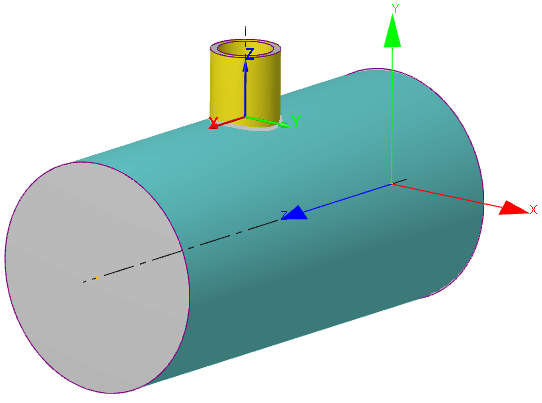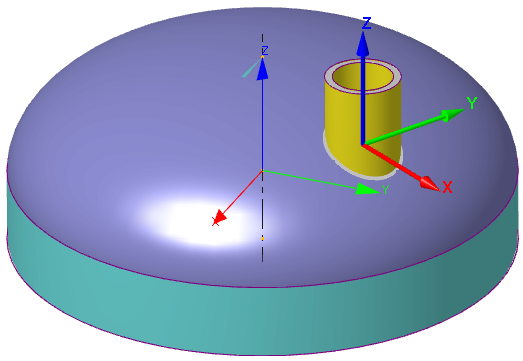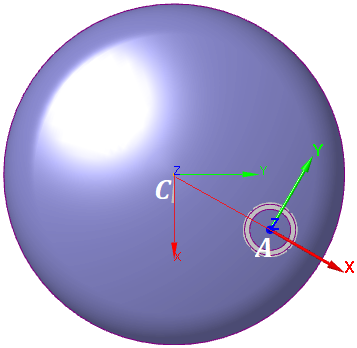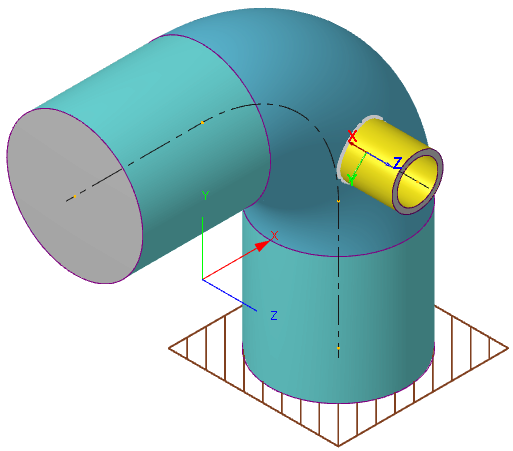

 |
PASS/NOZZLE-FEM 3.5. Program Manual |  |
The nozzle model is specified by a junction type with a base element, by the dimensions and section parameters, by its placement way relative to the base element, etc.
The description of the base element is given in the section: Base element setting.
Table 3.18 shows key features of the base element (shell).
| Table 3.18 | ||||||||||||||||||||||||||||||||||||||||||||||||
| Feature | Description | |||||||||||||||||||||||||||||||||||||||||||||||
| Nozzle local coordinate system (LCS), located on cylindrical or conical shells, including tank and vertical vessel: |
X-axis is directed along the local (longitudinal) Z-axis of the base element. Y-axis is directed along the normal to the ZX-plane; it is calculated as $e_y = e_z \times e_x$. Z-axis is directed along the longitudinal nozzle axis.  | |||||||||||||||||||||||||||||||||||||||||||||||
| Nozzle local coordinate system (LCS), located on heads: |
X-axis is directed along a straight line in the head plane passing through the center of the head and the nozzle end, that is from C-point to A-point (fig. 3.50). Y-axis is directed along the normal to the ZX-plane; it is calculated as $e_y = e_z \times e_x$. Z-axis is directed along the longitudinal nozzle axis. If the nozzle is central (offset is not set), then X-axis coincides with the local X-axis of the head. 
 | |||||||||||||||||||||||||||||||||||||||||||||||
| Nozzle local coordinate system (LCS), located on elbow (bend): |
X-axis is directed along the tangential axis of the central axial curve of the elbow (bend) element. Y-axis is directed along the normal to the ZX-plane; it is calculated as $e_y = e_z \times e_x$. Z-axis is directed along the longitudinal nozzle axis.  | |||||||||||||||||||||||||||||||||||||||||||||||
| Nozzle local coordinate system (LCS), located on rectangular plate: |
It coincides with local CS of base element (plate). | |||||||||||||||||||||||||||||||||||||||||||||||
| Placement in LCS of base element: | For cylindrical and conical shell the nozzle might be radial one (fig. 3.52a), be positioned in the cross-sectional plane (fig. 3.52b), as well as tilted (fig. 3.52c) and offset (fig. 3.52d).
For heads (fig. 3.53) the nozzle can be radial, positioned along the vessel's axis, or may be randomly positioned (tilted).
| |||||||||||||||||||||||||||||||||||||||||||||||
| Constraints (dof): | Absent in the all calculation schemes. | |||||||||||||||||||||||||||||||||||||||||||||||
| Nozzle loads: | Inner overpressure (except trunnion). Outer pressure (except trunnion). Hydrostatic pressure (except trunnion). Thermal strains. Concentrated loads in the juncture or on the nozzle end. More information in the section: Setting model loads. | |||||||||||||||||||||||||||||||||||||||||||||||
| Shell loads: | Described in the section: Base element setting. | |||||||||||||||||||||||||||||||||||||||||||||||
| Special calculations: | Allowable loads; Stiffness and flexibility factors; Stress intensification factors; Calculation as per WRC 537(107)/297. Calculation of opening reinforcement as per GOST 34233.3-2017. | |||||||||||||||||||||||||||||||||||||||||||||||
| Nozzle junction types: |
Design model of nozzle hole reinforcement corresponds to fig. 3.54. Also barrel existence can be added. Trunnions can be calculated with ring pad reinforcement and without it. For storage tanks available models with tombstone shape reinforcing plates [20].
| |||||||||||||||||||||||||||||||||||||||||||||||

PASS/NOZZLE-FEM 3.5. Program Manual
Copyright © 2017-2025, PASS Team